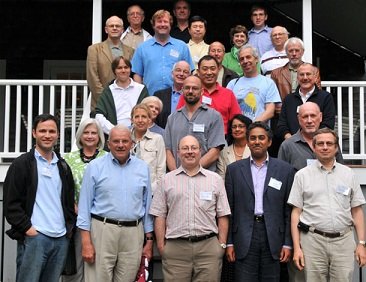
The August 2009 workshop of the Initiative’s Astrocytes and Glaucomatous Neurodegeneration. Credit: Milos Pekny
Glaucoma is often called the sneak thief of vision because it can develop without obvious symptoms. Whereas certain risk factors are apparent — high intraocular pressure and age — exactly how these risk factors contribute to the disease is by no means clear.
The first program of the Lasker/International Retinal Research Foundation’s Initiative for Innovation in Vision Science, launched in 2009, explored the dual role of astrocytes in glaucoma. Astrocytes are cells that perform many functions to maintain healthy optic nerve tissue but have also been implicated in playing a negative role in glaucomatous degenerative disease.
The Initiative convened two workshops with experts in diseases of the retina and glaucoma, as well as bench and clinical scientists with expertise in a number of complementary fields,whose combined skills, knowledge, and experience could point the way toward an understanding and eventual cure of this disease. Participants identified and refined the main unsolved questions, as well as important areas for further glaucoma research that may now be experimentally addressed using modern techniques.
In March 2010, workshop participants and other scientists with expertise that could fill additional knowledge gaps met and outlined a plan of potential studies to surmount hurdles that have hindered progress in this field. “Astrocytes and Glaucomatous Neurodegeneration,” a report published by the Initiative in November 2010, summarizes this comprehensive examination of how astrocytes function in health and disease. The report also articulates the challenges to better understanding how astrocytes may play a key role in glaucoma and outlines innovative approaches that could advance new methods to diagnose, treat, and even prevent this devastating and intractable disease.
In addition to mapping ways to understand the role of astrocytes in glaucoma and neurodegenerative disease, the report serves as an important platform on which to launch new collaborative research efforts to further our understanding and response to not only glaucoma, but a myriad of other poorly understood conditions.
This report was created as part of the IRRF Initiative.
